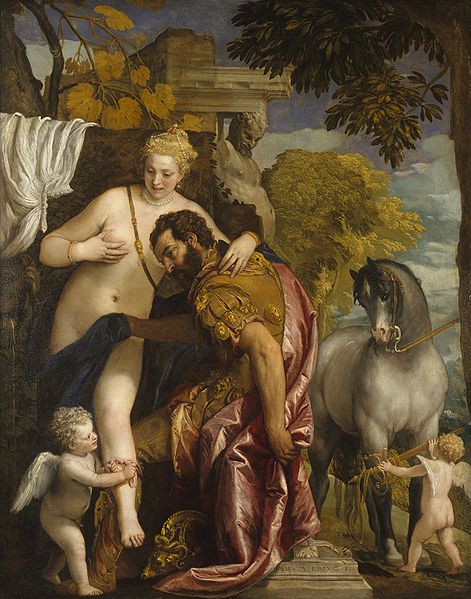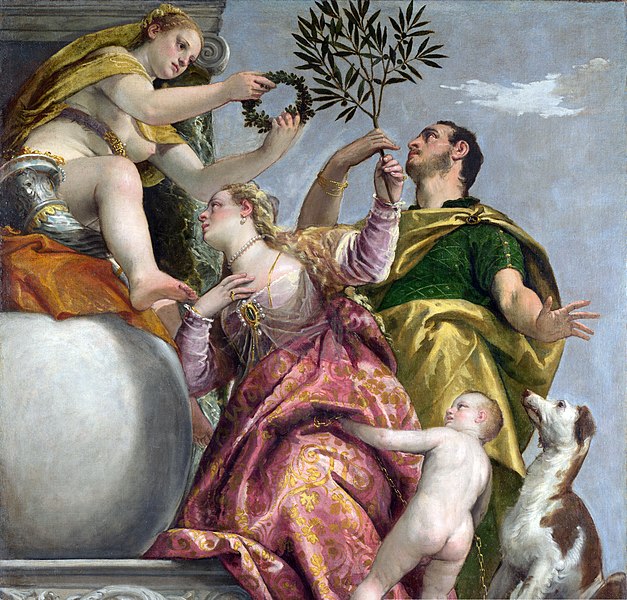19 March – 15 June 2014
The National Gallery, Trafalgar Square, London
See also Veronese’s Allegories: Virtue, Love, and Exploration in Renaissance Venice
'Veronese: Magnificence in Renaissance Venice' is devoted to one of the most influential artists of the 16th century. This exhibition of 50 of his works, many of which are travelling to London from across the globe, is the most significant collection of masterpieces by the artist ever to be displayed in the United Kingdom.
Paolo Caliari (1528–1588), known as Veronese, was one of the most renowned and sought-after artists working in Venice in the 16th century. His works adorned churches, patrician palaces, villas and public buildings throughout the Veneto region – and are inseparable from our idea of the opulence and grandeur of the Republic of Venice at that time.
'Veronese: Magnificence in Renaissance Venice' brings together works from every aspect of the artist’s oeuvre: portraits, altarpieces, allegorical decorations and mythological works. Paintings in this exhibition represent the very peak of the artist’s output at every stage of his career.
Important loans to the exhibition include works from churches and art galleries across Europe (Austria, France, Italy and Spain) and the USA.
The exhibition displays many of Veronese’s most celebrated works, including

'The Martyrdom of Saint George' (about 1565)
on loan from the church of San Giorgio in Braida, Verona,

and 'The Mystic Marriage of Saint Catherine' (1565-70, Gallerie dell’Accademia, Venice).
Neither of these great altarpieces has previously been seen in the United Kingdom. The exhibition will enable visitors to compare them with Veronese's most accomplished secular painting of the same period, the magnificent
'Family of Darius before Alexander' (1565–7),
which was among the first great works acquired by the National Gallery in mainland Europe.
Highlights of the exhibition include the display of three of the artist’s most beautiful portraits from the period of his arrival in Venice:

'Portrait of a Gentleman' (about 1555, Palazzo Pitti, Florence),
the 'Portrait of a Woman, known as the 'Bella Nani'' (about 1555–60, Musée du Louvre, Paris)

* Paolo Veronese (1528-1588)
Portrait of a Lady, known as the “Bella Nani”, about 1560-5
Oil on canvas, 119 × 103 cm
Musée du Louvre, Paris (R.F. 2111)
© RMN (Musée du Louvre)/All rights reserved

and the 'Portrait of a Gentleman' (1560-65, The J. Paul Getty Museum, Los Angeles).
Works are reunited in the exhibition for the first time in hundreds of years.

'Mars and Venus United by Love' (about 1570-1575, The Metropolitan Museum of Art, New York)
leaves the USA for the first time since 1910 for the exhibition and is reunited, for the first time since the 18th century, with
the National Gallery’s 'Four Allegories of Love' (about 1575):

Allegory of Love I Infidelity

Paolo Veronese (1528-1588)
Allegories of Love II – Scorn, about 1570-75
Oil on canvas
186.6 ×188.5 cm
© The National Gallery, London (NG 1324)

Allegory of Love III Respect

Allegory of Love IV The Happy Union
Two companion altarpieces painted for the church of San Benedetto Po near Mantua:

'The Virgin and Child with Saints Anthony Abbot and Paul the Hermit' (1562, Chrysler Museum of Art, Norfolk, Virginia)

and the National Gallery’s own 'Consecration of Saint Nicholas' (1562),
are displayed together for only the second time since the 18th century.

The Gallery’s 'Adoration of the Kings' (1573),
painted for the church of San Silvestro in Venice, long one of the artists most admired paintings and recently cleaned, will be shown beside
an altarpiece of the same subject, painted in the same year for the church of in Santa Corona, Vicenza.
These pictures have never been seen together since they were in the artist’s studio.
Born in Verona in 1528, the son of a stonecutter, Veronese entered into the workshop of Antonio Badile in 1541. Working in Verona, he completed important commissions for churches and aristocratic families such as the Canossa and Bevilacqua.
In the early 1550s, Veronese moved to Venice, a city he rarely left. It was here, endorsed by Titian, and working alongside Jacopo Sansovino and Andrea Palladio, that he was established as one of the leading artists in Europe. His posthumous reputation has been as consistently high as his influence has been strong. The work of Van Dyck, Rubens, Watteau, Tiepolo and Delacroix depend upon his example.
'Veronese: Magnificence in Renaissance Venice' is curated by Xavier F. Salomon, Curator of Southern Baroque at the Metropolitan Museum of Art, New York.
More images from the exhibition:

Paolo Veronese (1528-1588)
Christ and the Centurion, about 1570
Oil on canvas
192 × 297 cm
© Madrid, Museo Nacional del Prado (P00492)

Paolo Veronese (1528-1588)
Perseus and Andromeda, 1575-80
Oil on canvas
260 × 211 cm
Musée des Beaux – Arts, Rennes
Excellent Review
Organisation
'Veronese: Magnificence in Renaissance Venice has been organised in association with the Museo di Castelvecchio, Verona, to complement its exhibition 'Paolo Veronese' (5 July – 5 October 2014).
Publication

'Veronese'
By Xavier F. Salomon
Hardback ISBN 9781857095531
Paperback ISBN 9781857095548
Published by National Gallery Company
Distributed by Yale University Press_Gentleman_in_a_Lynx_Fur_-_WGA24981.jpg" />